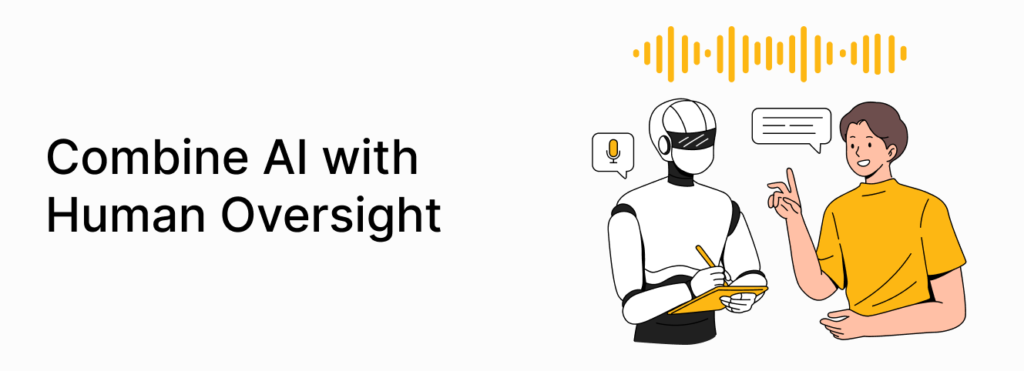As we navigate the intersection of artificial intelligence and digital marketing, we’ve gathered insights from CEOs and Chief Marketing Officers to address the potential pitfalls. From preserving brand uniqueness to blending AI efficiency with human creativity, here are five key strategies to mitigate the risks of AI-generated content writing.
Table of Contents
Preserve Brand Uniqueness with AI
One key insight into the potential risks of relying on AI-generated content for your digital strategy is the danger of sounding like your competition. The more AI-generated content is used for blog posts, social media content, and digital marketing, the more similar the content is likely to become. There is a high risk of losing the unique voice, personality, and messaging of a small business.
Here are three ways to reduce these risks.
- Create a document that contains your business’s mission, vision, and core values. This document should have all the information that makes your business unique, including your ideal customer persona, their pain points, and archetype. It should contain your marketing strategy and goals. This document should clearly communicate who you are and the customers you serve. When using AI, upload this document and include a reference to the document in your prompt. This will ensure that the AI uses your information as a reference to respond to your prompt.
- Use multiple AI tools as part of the process. Use ChatGPT to do some keyword research and build an outline, and then use Claude to create the copy. Using multiple LLMs in the process will diversify the output and keep your content from sounding like everyone else.
- Human editing is vital. You cannot take the output of AI models and publish them without human editing. As a marketer, you are creating content for humans, not machines. Therefore, a human must be part of the content creation process to ensure it connects with human emotion and experience.
These three steps will help mitigate the potential risk of relying on AI-generated content for the digital marketer.
Alan Smith, CEO, Tracsoft
Ensure Accuracy and Brand Voice
One major risk when solely relying on AI-generated content for digital marketing is inaccuracies in facts and mimicking the brand voice. This may happen through the inheritance of bias and factual mistakes from large language models that train on massive text data. This could be misleading or even irrelevant to the interests of the target audience. More human involvement in the process is needed to manage these risks.

For instance, SMEs could revise and edit AI-written content for accuracy and on-brand messaging. Modulation can be further driven by techniques such as style guides for the brand being included within the LLM architecture by priming with the brand-specific tone, which may drive a more consistent and authentic brand voice.
Dhari Alabdulhadi, CTO and Founder, Ubuy New Zealand
Implement Expert Content Review Processes
One key insight into the potential risks of relying on AI-generated content for digital marketing is the possibility of inaccurate information and hallucinations. AI tools may generate content that inadvertently produces this content, which can lead to reputational damage and incorrect follow-on materials. To mitigate this risk, businesses should implement thorough content review processes using experts in the field, and ensure proper QA for any AI-generated works. Additionally, establishing clear guidelines for AI use and regularly updating them in compliance with evolving laws can help safeguard against potential inaccuracies.
Shawn Ford, Partner at Ceiba Law – Incident Response & Privacy Lawyer | Founder & CEO at RIGC – Strategic Risk & Crisis Management Advisor, Ceiba Law | Resolution Insight Group Corp.
Combine AI with Human Oversight
AI-generated content risks producing content that is inaccurate, misleading, or offensive. While AI tools are getting smarter, they still lack the nuanced understanding and judgment of human writers. AI-generated text can be repetitive, fail to consider important context, and contain factual errors or inappropriate language. To mitigate these risks, marketers should not rely solely on AI-generated content. Instead, they should use AI as an assistive tool to supplement human writers. Here are two practical steps:

- Have human writers review all AI-generated content before publishing to catch any errors or problematic content. Editors act as a necessary checkpoint to ensure quality and appropriateness.
- Train AI models with large, high-quality datasets that have been screened for bias and accuracy. The more a model is exposed to nuanced, fact-checked human writing, the smarter its own generated content will become over time.
Ultimately, while AI tools have a role to play, human oversight remains essential for digital marketing content to be effective and to avoid potential risks.
Mahee Chouhan, Content and Digital Marketing Manager, Mitt Arv
Blend AI Efficiency with Human Creativity
One key risk of relying on AI-generated content for digital marketing is that it can sometimes miss the mark in understanding human emotions and context. AI might produce text that sounds good but lacks the genuine touch that resonates with people.
In my blogging company, we found that AI could generate a lot of content quickly, but it sometimes felt robotic and missed the nuances of our audience’s needs. To mitigate this, we always have a human review and edit the AI-generated content. This way, we ensure it maintains the right tone and connects better with our readers.
For example, in my adventure travel company, we use AI to draft initial trip descriptions but then add personal stories and insights to make them more engaging. Combining AI efficiency with human creativity has been key to maintaining quality and authenticity in our content.
Swena Kalra, Chief Marketing Officer, Scott & Yanling Media Inc.





























